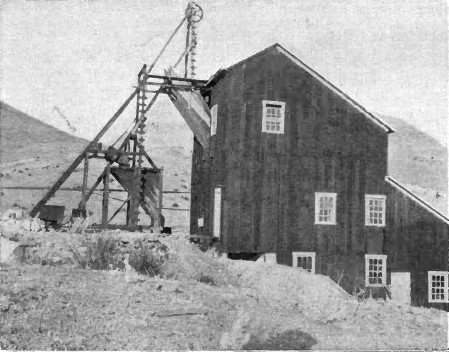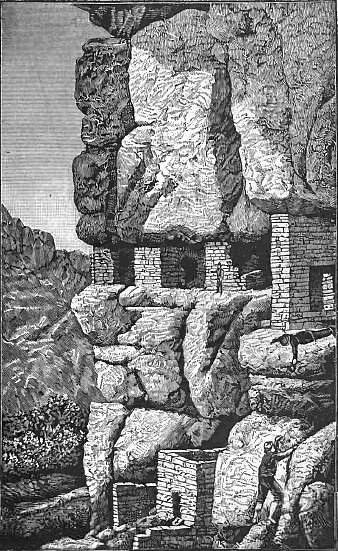The famous Vulture mine, in desert hills eleven miles from the railroad town of Wickenburg, has had broad renown as the greatest producer of gold ever known in the Southwest and tales of its output run up to $10,000,000. It was (and is) a great mine, but hardly to the extent quoted. It was discovered late in 1863 by Henry Wickenburg, who had been a member of the Weaver party. The mine at first was a pile of almost loose rock, with native gold visible to the naked eye anywhere across a thirty-foot ledge. It is told that miners became wealthy by simply bringing away pockets or lunch cans full of quartz gold ore that at times carried a volume of more than half of the precious metal.
Apaches swarmed in the vicinity and many travelers were killed between the waterless mine and the river. ]More than forty arastras at one time were being operated on the river on ore from the Vulture. Charlie Genung happened along in July, 1864, in time to help Wickenburg build his first arastra, the first clean-up realizing $100 from a ton of ore. The arastras in general were operated by contractors, who paid Wickenburg $15 a ton for ore at the mine, the buyer doing his own mining and packing and generally making by his deal. In 1865 the arastras had been succeeded by two small mills at the Town of Wickenburg, said to have been so named by Governor Goodwin. One of these mills was built by Michael Goldwater, who took a mortgage on the first product to secure his pay. He ran the mill a month, realizing $3,000 a day and then turned it over; the bonanza ore was gone and the ledge matter had dropped in value to $30 a ton. In the spring of 1866 the main claim was bought for $75,000 by B. Phelps of New York, a miner of prior experience at the Picacho, near La Paz, and in the Heintzelman and Cababi camps. Thereafter a twenty-stamp mill was built at Wickenburg. The gross gold product for about a year, to September, 1867, was only $45,633. A better story was told, however, by the noted western assayer, Thomas Price, who estimated that the Vulture Company, within six years, crushed 118,000 tons of quartz, with extraction of about $2,500,000.
The mine has passed through the hands of many operators, some of whom have used it merely for stock selling. The ores have been reduced at several points along the Hassayampa, particularly at Smith's mill and at Seymour. Still later an eighty-stamp mill was erected at the mine, where ore of very low grade was successfully handled until a pipe line from the Hassayampa was swept away by the flood of 1890. During a lease of the property, the (old stone buildings at the Town of Vulture were torn down and run through the mill and it is told that the walls averaged about $20 to the ton in gold.
The mine worked only to the depth of 550 feet on an incline, when a fault was encountered. The old workings largely caved in and became a wreck. During the last few years a new company operating the mine has sunk at a different point and again has found the lead, almost as rich as it was in pioneer days.
Despite the richness of the surface ores and the fact that he received a gross sum approaching $100,000 when he sold the claims, Wickenburg failed to hold more than a very modest competency. His death was at his own hand, by a bullet through the brain, in his little adobe house on the Hassayampa a short distance below the town that bore his name. He was aged about 86. An investment of $550,000 was represented in the works of the Arizona Smelting Company at Humboldt, "blown in" during March, 1906. This plant, designated to furnish an outlet for the ores of the small mines of Yavapai County, has had a checkered career, mainly remarkable for the quantity of bonds that were sold upon the strength of its operations. Latterly it has passed into the hands of a company which appears to be operating it for profit locally derived. In the same district has been a number of remarkable experiments in the way of reduction plants, which have failed as soon as tested. The Bradshaw Mountains near by, found productive in pioneer days, now are yielding their riches in greater volume than ever before, the miners assisted by modern methods in realizing value contained in ores once called rebellious and hence considered worthless.
On the southwestern spurs of the Bradshaws, beyond the famous diggings of Rich Hill, lies the once-famous Congress, the deepest mine of the Southwest, with an incline shaft over 4,000 feet in length. This mine was bought in 1887 by "Diamond Jo" Reynolds of St. Louis, locally represented by Frank M. Murphy. Reynolds died at the camp in March, 1891, some months after the start of the mill. The property was very productive for years, but finally proved unprofitable. A few miles distant is the well-known Octave property.
Return
to The Arizona Page:
Arizona Gold Rush Mining History



